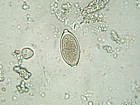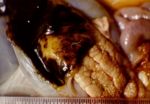Difference between revisions of "Trichuris"
| Line 1: | Line 1: | ||
{{unfinished}} | {{unfinished}} | ||
| − | + | {| cellpadding="8" cellspacing="0" border="1" | |
| − | + | | Also known as: | |
| + | | whipworm | ||
| + | |- | ||
| + | |} | ||
| + | |||
[[Image:Trichuris ovis sheep.jpg|thumb|right|150px|''Trichuris ovis'' from sheep faeces - Joaquim Castellà Veterinary Parasitology Universitat Autònoma de Barcelona]] | [[Image:Trichuris ovis sheep.jpg|thumb|right|150px|''Trichuris ovis'' from sheep faeces - Joaquim Castellà Veterinary Parasitology Universitat Autònoma de Barcelona]] | ||
[[Image:Trichuris ovis.jpg|thumb|right|150px|''Trichuris ovis'' in caecum - Supplied by Biomed Image Archive]] | [[Image:Trichuris ovis.jpg|thumb|right|150px|''Trichuris ovis'' in caecum - Supplied by Biomed Image Archive]] | ||
[[Image:Trichuris vulpis.jpg|thumb|right|150px|''Trichuris vulpis'' - Courtesy of the Laboratory of Parasitology, University of Pennsylvania School of Veterinary Medicine]] | [[Image:Trichuris vulpis.jpg|thumb|right|150px|''Trichuris vulpis'' - Courtesy of the Laboratory of Parasitology, University of Pennsylvania School of Veterinary Medicine]] | ||
| − | == ''Trichuris'' | + | ==Overview ==ave a direct lufe cycle, moving directly into the definitive host from the infecive L1 egg stage. |
| − | + | The ''Trichuris'' worms are so called due to their characteristic whipe like structure. They have a broad posterior end tapering to a long and narrow neck which is inserted into the caecal mucosa. They have a direct lufe cycle, moving directly into the definitive host from the infective L1 egg stage. Once ingested the larva is freed from the egg casing and forms a mucosal nodule in which to develop before emreging into the lumen of the gastointestinal system. | |
*Eggs are brown, barrel-shaped, with a plug at either end, and can survive for up to 12 years | *Eggs are brown, barrel-shaped, with a plug at either end, and can survive for up to 12 years | ||
*The infective stage is the embryonated egg. | *The infective stage is the embryonated egg. | ||
*The life-cycle is direct | *The life-cycle is direct | ||
| − | |||
| + | ==Characteristics== | ||
| + | '''Eggs''' | ||
| + | The eggs of '' Trichuris species are brown in colour and are bioperculated (have a plug in each end). They are hardy eggs and in the correct coonditions can survive on pasture for up to 12 years. | ||
| + | '''Larvae''' | ||
| + | '''adult''' | ||
==Species== | ==Species== | ||
| Line 41: | Line 49: | ||
[[Category:Trichinelloidea]] | [[Category:Trichinelloidea]] | ||
| − | [[Category:To_Do_- | + | [[Category:To_Do_-_NickJ]] |
Revision as of 08:12, 10 July 2010
| This article is still under construction. |
| Also known as: | whipworm |
==Overview ==ave a direct lufe cycle, moving directly into the definitive host from the infecive L1 egg stage. The Trichuris worms are so called due to their characteristic whipe like structure. They have a broad posterior end tapering to a long and narrow neck which is inserted into the caecal mucosa. They have a direct lufe cycle, moving directly into the definitive host from the infective L1 egg stage. Once ingested the larva is freed from the egg casing and forms a mucosal nodule in which to develop before emreging into the lumen of the gastointestinal system.
- Eggs are brown, barrel-shaped, with a plug at either end, and can survive for up to 12 years
- The infective stage is the embryonated egg.
- The life-cycle is direct
Characteristics
Eggs The eggs of Trichuris species are brown in colour and are bioperculated (have a plug in each end). They are hardy eggs and in the correct coonditions can survive on pasture for up to 12 years. Larvae adult
Species
- Trichuris vulpis - dog whipworm
- Trichuris campanula (Europe) and Trichuris serrata (North America) - cat whipworms.
- Are quite rare.
- Trichuris suis - pig whipworm
Life Cycle
- Faeco-oral spread
- Eggs become infective after 10-14 days in soil.
- Larvae hatch in small intestine.
- Grow and moult.
- Finally take up resisidence in large intestine.
- I.e. NO tissue migratory phase.
Clinical
- Adult buries its thin anterior half into the intestinal mucosa and feeds on tissue secretions (not blood).
- The caecum and colon are the most commonly infected sites.
- Causes eosinophilia.
- Signs may include:
- Diarrhoea
- Anemia
- Dehydration


